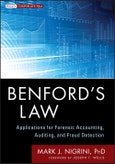Benford's Law gives the expected patterns of the digits in the numbers in tabulated data such as town and city populations or Madoff's fictitious portfolio returns. Those digits, in unaltered data, will not occur in equal proportions; there is a large bias towards the lower digits, so much so that nearly one-half of all numbers are expected to start with the digits 1 or 2. These patterns were originally discovered by physicist Frank Benford in the early 1930s, and have since been found to apply to all tabulated data. Mark J. Nigrini has been a pioneer in applying Benford's Law to auditing and forensic accounting, even before his groundbreaking 1999 Journal of Accountancy article introducing this useful tool to the accounting world. In Benford's Law, Nigrini shows the widespread applicability of Benford's Law and its practical uses to detect fraud, errors, and other anomalies.
- Explores primary, associated, and advanced tests, all described with data sets that include corporate payments data and election data
- Includes ten fraud detection studies, including vendor fraud, payroll fraud, due diligence when purchasing a business, and tax evasion
- Covers financial statement fraud, with data from Enron, AIG, and companies that were the target of hedge fund short sales
- Looks at how to detect Ponzi schemes, including data on Madoff, Waxenberg, and more
- Examines many other applications, from the Clinton tax returns and the charitable gifts of Lehman Brothers to tax evasion and number invention
Benford's Law has 250 figures and uses 50 interesting authentic and fraudulent real-world data sets to explain both theory and practice, and concludes with an agenda and directions for future research. The companion website adds additional information and resources.
Table of Contents
Foreword xiPreface xiii
About the Author xix
Chapter 1: Introduction and Mathematical Foundations 1
Benford's Expected Digit Frequencies 5
Defining the First and First-Two Digits 6
Digit Patterns of U.S. Census Data 8
Logging on to Benford's Law 10
General Significant Digit Law 13
Log and Behold, the Census Data 13
Love at First Sight 15
Mantissa Test and Census Data 19
Number of Records and Benford's Law Tests 20
When Should Data Conform to Benford's Law? 21
Conclusions 23
Chapter 2: Theorems, Truisms, and a Little Trivia 25
Digits of Corporate Payments Data 26
Digits of Lake Data 28
Scale Invariance Theorem 31
Mean Absolute Deviation 34
Scale Invariance and Census Data 34
Scale Invariance and Corporate Payments 35
Scale Invariance and Lake Data 36
A Level Playing Field Becomes Benford 38
Multiplication by 1/X 42
All Distributions Lead to Benford 43
Getting a Gripf on Benford and Zipf 46
Conclusions 50
Chapter 3: More Formulas and Facts, and a Little Fibonacci 51
Fibonacci Numbers 51
Lucas Numbers 53
Back to Square One 55
3nþ1 Problem 58
Ultimate Uniform Distribution 60
Benford Embraces Other Bases 62
Nigrini's Second Last Theorem 65
Conclusions 69
Chapter 4: Primary Benford’s Law Tests 71
Corporate Payments Data 72
Data Profile 72
First Come, First Served 74
Playing Second Fiddle 75
First-Two Digits Test 78
Running the Digit Tests in Excel 80
Running the Digit Tests in Access 83
Conclusions 87
Chapter 5: Advanced Benford’s Law Tests 89
Summation Test 90
Running the Summation Test in Excel 94
Running the Summation Test in Access 95
Second-Order Test 97
An Analysis of Payments Data 102
An Analysis of Journal Entry Data 104
An Analysis of Census Data 107
Running the Second-Order Test in Excel 108
Excel, Thanks a Million(s) 110
Scale Invariance and the Second-Order Test 113
Conclusions 114
Chapter 6: Associated Benford’s Law Tests 117
Number Duplication Test 117
An Analysis of Payments Data 119
An Analysis of Census Data 121
Running the Number Duplication Test in Excel 122
Running the Number Duplication Test in Access 126
Last-Two Digits Test 129
An Analysis of Payments Data 130
An Analysis of Census Data 131
An Analysis of Election Results 132
Running the Last-Two Digits Test in Excel 135
Running the Last-Two Digits Test in Access 136
Distortion Factor Model 138
Distortion and the Census Data 145
Conclusions 146
Chapter 7: Assessing Conformity to Benford's Law 149
Z-Statistic 150
Chi-Square Test 153
Kolmogorov-Smirnoff Test 157
Mean Absolute Deviation Test 158
The Logarithmic Basis of Benford's Law 160
Creating a Perfect Synthetic Benford Set 163
Mantissa Arc Test 165
Conclusions 169
Chapter 8: Examples of Fraudulent Data 171
The Inside Story 172
The Vendor Who Never Was 174
Not Paying Attention 175
Funny Money 177
The Heart of the Matter 181
Going the Extra Mile 182
Laugh All the Way to the Bank 184
Culture Shock 187
Having a Bad Hair Day 189
An Unclean Bill of Health 191
Turning the Table on Tax Evasion 193
Conclusions 196
Chapter 9: Fraudulent Financial Statements, Part I 199
Number Crunching 200
Wrong Numbers 205
A Look at Enron's and AIG’s Numbers 207
Figuring Out the Controllers 210
Conclusions 213
Chapter 10: Fraudulent Financial Statements, Part II 215
Digital Yoga by Absaroka 216
Can’t See the Forest for the Trees 218
Digit a Little Deeper into Papua New Guinea 221
The Good, the Bad, and the Ugly 227
Dig a Little Deeper 233
There Are More Questions than Answers 237
Conclusions 244
Chapter 11: Madoff and Other Ponzi Schemes 247
The Madoff Claims 248
Don't Bank on Kaupthing 249
The Whole Ball of Waxenberg 252
General Motors Demoted to Private 253
Chrysler Unable to Dodge Bankruptcy 255
Discussion of the Claims Results 258
A Review of the Madoff Returns 259
Apple, Dell, Berkshire, and Benford 262
Discussion of the Returns Results 265
Chapter 12: Earth Science and Income Tax Applications 267
Still Waters Run Deep 268
The Lay of the Lake 274
For a Few Dollars Less 281
A Clean Bill of Clinton 286
Conclusions 290
Chapter 13: Future Directions and Conclusions 293
My Law 295
Insights into Number Invention 300
Lehman's Charitable Gifts 306
The Bottom Line 310
Glossary of Selected Terms 315
References 323
Index 327








